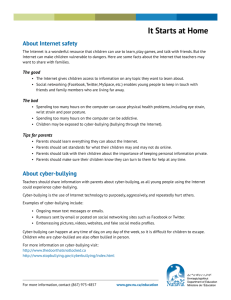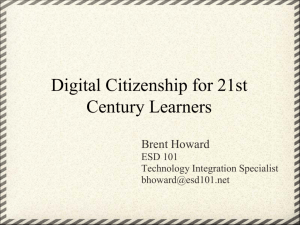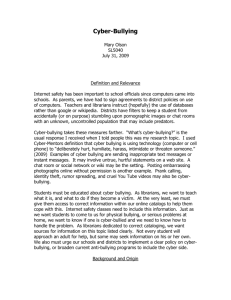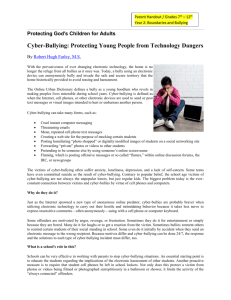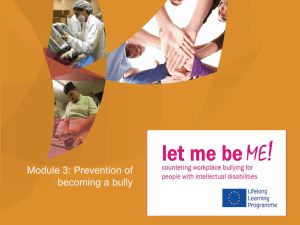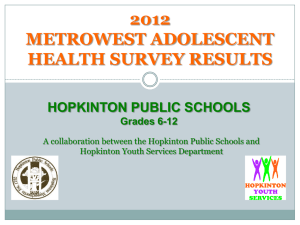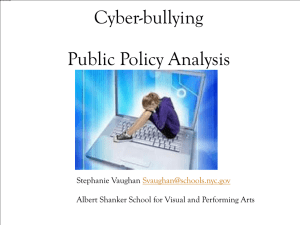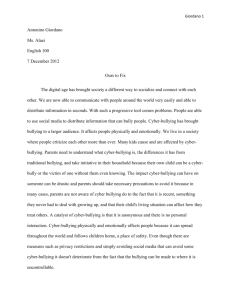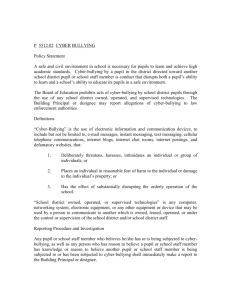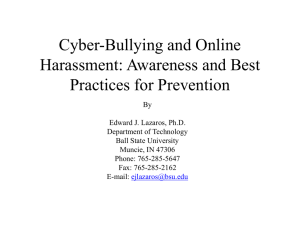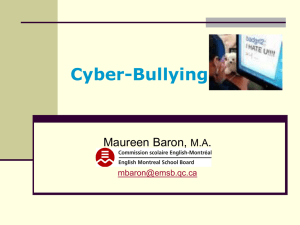SGS - Midterm Action Research Project
advertisement
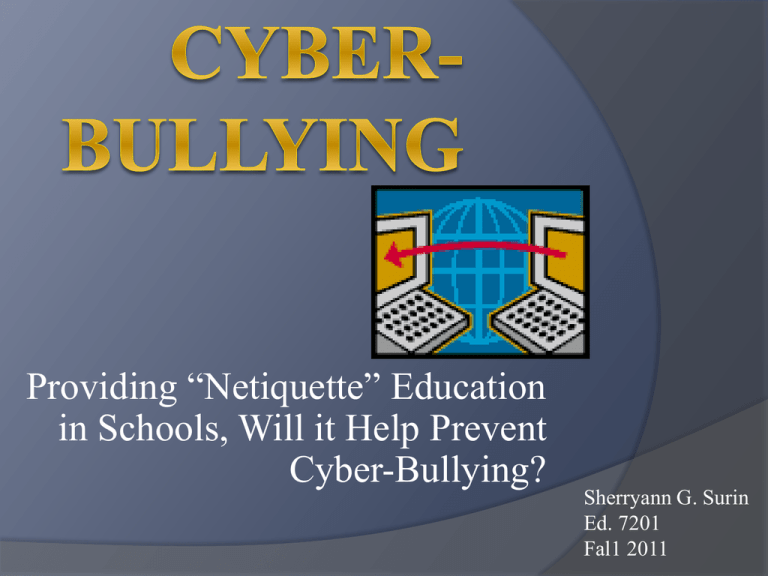
Providing “Netiquette” Education in Schools, Will it Help Prevent Cyber-Bullying? Sherryann G. Surin Ed. 7201 Fal1 2011 Table of Contents Introduction Statement of the Problem Review of Literature Statement of the Hypothesis Resources Statement of the Problem New form of school violence on the rise added to the traditional bullying, it is called cyber-bullying. Cyber-Bullying is a problem with school-aged children all around the world. Children are always connected or wired, and communicate in ways that are sometimes not supervised by adults. Therefore, it makes it difficult for parents and school administrators to understand the nature of the problem and do something about it. Review of Literature New and emerging technologies have made it easier for bullies to gain access to their victims. Cyber-bullying, while its intent is to hurt others through power and control, it is different due to the use of these new technologies (Keith & Martin, 2005). Cyber Bully Tools Instant Messaging (IM) ○ Text IM, full screen video conversation, file sharing, & calling capabilities Mobile Phones ○ Text messaging, pictures, & video clips Email Messages ○ Verbal, audio, and visual material Social Networking Sites (Bhat, 2008) Review of Literature Features of cyber-bullying that distinguish it from conventional bullying A infinite audience An inability of the cyber-bully to see the immediate reaction of the victim There is no limitation on the bullying beyond the schoolyard (Bauman, 2010) Research conducted on cyber-bullying 3,765 school-aged students in Canada ○ Studies found , 49% students indicated they had been electronically bullied, 7% indicated they were bully/victims, and 4% indicated they had electronically bullied others. (Kowalski & Limber, 2007) Review of Literature Research conducted on cyber-bullying 2,186 diverse school-aged students in United States ○ Studies found , 49% students indicated they had been bullied online and 33.7% indicated they had bullied others online. (Cook, Daciuk, Gadalla, Mishna, & Solomon, 2010) Vygotsky's Sociocultural Theory - children construct knowledge in the culture through social processes. Any form of bullying results from power differences between various social groups with different levels of power. Gender, race, ethnicity, or social class is usually the difference between groups. (Gauvain, 2008) Review of Literature To prevent cyber-bullying, educate students about how to avoid socially, inappropriate behavior, what the consequences are if the cyber-bullying behavior is exhibited, and how to respond to and report bullies (Hummell, 2007). Three tips: ○ Educators should implement interactive educational program on cyber citizenship ○ Get peer counseling groups involved ○ Get expert help Providing internet etiquette (netiquette) education in schools about how to use social networking sites in positive ways is a measure that should be taken in order to prevent cyber-bullying. Students would be taught how to be respectful through technological communication and how to avoid being a victim of cyber-bullying (Pfister, 2010). Statement of Hypothesis HR1: My Demonstration Method of teaching netiquette (Internet etiquette) over an eight week period, three times a week for fortyfive minutes each during one period at PS XX in Brooklyn, NY will increase eighteen students’ knowledge of appropriate use of new and emerging technologies. HR2: My Demonstration Method of teaching netiquette (Internet etiquette) over an eight week period, three times a week for fortyfive minutes each during one period at PS XX in Brooklyn, NY will decrease cyber-bullying. Resources Keith, S., & Martin, M.E. (2005). Cyber-Bullying: Creating a Culture of Respect in a Cyber World. Reclaiming Children and Youth: The Journal of Strength-based Interventions, 13(4), 224-228. Bhat, S. C. (2008). Cyber Bullying: Overview and Strategies for School Counselors, Guidance Officers, and All School Personnel. Australian Journal of Guidance & Counseling, 18(1), 53-66. Retrieved from Education Research Complete EBSCOhost. Bauman, S. (2010). Cyberbullying in a Rural Intermediate School: An Exploratory Study. The Journal of Early Adolescence, 30(6), 803-833. Kowalski, R.M., Limber, S.P. (2007). Electronic Bullying Among Middle School Students. Journal of Adolescent Health, 41(6), Supplement, S22-S30 Retrieved from http://www.sciencedirect.com/science/article/pii/S1054139X07003618 Cook, C., Daciuk, J., Gadalla, T., Mishna, F., & Solomon, S. (2010). Cyber bullying behaviors among middle and high-school students. American Journal of Orthopsychiatry, 80(3), 362-372. Resources Gauvain, M. (2008). Vygotsky’s Sociocultural Theory. In Haith, M.M. & Benson, J.B. (Eds.), Encyclopedia of Infant and Early Childhood Development, 3, 404-413. Oxford, United Kingdom: Academic Press. Retrieved from http://go.galegroup.com/ps/i.do?&id=GALE%7CCX4097900170&v=2.1&u=cuny_ broo39667&it=r&p=GVRL&sw=w Hummell, L. (2007). Cyber-bullying: What It Is and How to Prevent It. Delta Kappa Gamma Bulletin, 73(3), 26-27. Retrieved from EBSCOhost. Pfister, J. (2011). Teaching internet etiquette: Dealing with Cyberbullying. Gateway Journalism Review, 41(323), 18-19. Retrieved from http://go.galegroup.com/ps/i.do?&id=GALE%7CA265290719&v=2.1&u=cuny_br oo39667&it=r&p=AONE&sw=w
